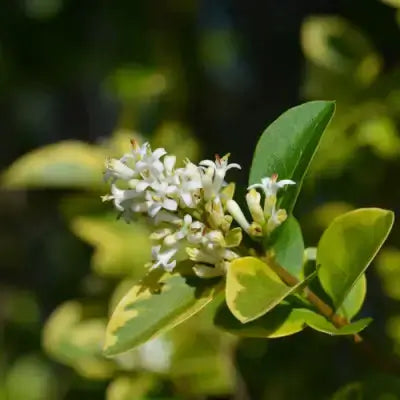What is a California Privet? What You Should Be Aware Of
California shrub is moderate in size; however, it can serve as a hedge, border, or screen, grows quickly, and is an evergreen shrub. it is a native plant in China and Korea and is grown in USDA zones 7 through 11. This plant can serve an aesthetic purpose in landscaping and can also provide privacy in a garden as well.
California shrub is moderate in size; however, it can serve as a hedge, border, or screen, grows quickly, and is an evergreen shrub. it is a native plant in China and Korea and is grown in USDA zons 7 through 11. This plant can serve an aesthetic purpose in landscaping and can also provide privacy in a garden as well.
This guide talks about the growth patterns and care of California privet, and what makes it differ from its cousins. It will also teach how to make sure properly planted California privet flourishes in your garden.
Adding a California Privet To Your Garden
Despite the head California privet, its origins is from the eastern half of Asia because it belongs to the genus Ligustrum. It can be used for privacy hedges since it grows quickly and is tolerant to different environmental conditions.
Physical traits of the California privet
Leaves: The California privet has a dense structure since the leaves and branches are packed. The leaves are also dark green and glossy which makes the hedges look even more appealing.
Flowers: Most flowering events occur between June and August. They appear at the end of the branches and take the form clusters of tiny and white flowers. They are pretty and very nice to look at. However, they do, indeed, have a sharp scent.
Size: Works excellently for hedging and as a stand-alone shrub. On average grows between 5 to 12 feet tall.
Fruit: Following the blooming period, the plant bears small and dark purple berries. These berries are inedible and can be toxic to pets and humans when swallowed.
How Do You Take Care of Them California Privet?
Taking care of these plants is quite straightforward. However, like every other living organism, some care is essential, especially after care having a lack of it in the establishment period.
Watering: Privets need to be watered daily. Appropriate soil for these plants needs to be damp and should be like this throughout the growing period. Plants should not sit in water. During the period of dormancy, water should be restricted.
Soil: The plant prefers a slightly acidic soil, ideally with a pH of 6.5 to 7.5. The soil should also be well-drained to avoid root rot.
Fertilizing: Balanced fertilizers can be used where N, P, and K are found in equal nitrogen, phosphorous, and potassium parts. Feeding every month in spring and summer will promote rapid growth.
Pruning: During the hedge’s dormant period, shape the California privet to hold the form of the hedge you wish it maintain. Remove the dead and dying growth, to promote healthy new growth.
Comparing California Privet to Other Popular Hedges
Though California privet is a popularly used hedge and screening choice, it is good to assess how it stands in comparison to other like plants such as Northern Privet. Wax Leaf Privet, Privet Hedge, etc
Boxwood (Buxus spp.)
Boxwoods grow slowly, are more compact and suited for formal hedges. However, they are more difficult to maintain and are not as heat tolerant as California privet.
Laurel (Prunus laurocerasus)
Like privet, laurel is an evergreen shrub that forms dense hedges. However, laurel grows significantly larger than the privet and will need more room in the garden.Holly (Ilex spp.): Holly is another favorite insulator plant having also ornamental appeal cultivated for its berries, although it is densely leaved, needs stringent care, and is more prone to diseases, such as leaf spot.
Though California privet is a superb plant for hedges requiring low maintenance and growing quickly, other plants such as boxwood and holly could be more appealing, depending upon personal taste.
Where to buy your California privet?
Since you have knowledge about the Privet and know how to take care of it, it would be ideal to have this Amercian shrub for sale in your house. As the case with the other several types of plants in the TN online nursery, you can also find California Privet there. If you need a shrub for your garden which forms a bold hedge and is very low maintenance, you can get that too in TN nursery. They have a wide range of plants to fulfill all your landscaping requirements.
FAQ About California Privet
Are California Privet Berries Edible?
Privet California berries are non-edible. Though the tiny, dark purple berries are visually appealing, they are toxic to both people and animals upon ingestion. As a result, it is important not to consume the berries, as well as to protect children and animals who might be encouraged to try them.
How Tall Does California Privet Get?
The California Privet shrub usually grows between 5 to 12 feet tall depending on the external factors and care given to the shrub. Most of the time it is pruned to the height required especially when it is used as a shrub border.
What Is California Privet Used For?
California privet is mainly used for hedging and screening. The dense foliage creates thick screening and windbreaks which are useful in gardens, parks, and even in cities. The shrub is also used for landscaping because of its shiny leaves and sweet scented flowers.
What Are the Disadvantages of Privet?
California shrub is along the easiest plant to grow and maintain. Although, it does have negative concerns. In certain regions, it spreads in a uncontrollable fashion and overpowers the surrounding flora while perpetuating its invasive streak.
Is Privet Good for Anything?
Yes, California privet is one of the most popular plants used for privacy screens and hedges because it grows quickly and has dense foliage. The shrub can be used for landscaping in both informal and formal situations. California privet also gives shelter to some birds and insects.
What is the most poisonous plant to a dog?
California privet is still not the most dangerous plant to dogs. Oleanders, sago palms, and azaleas are much more poisonous, and only these are a few of example poisons. Whereas, if a dog was to eat a part of these plants, I would suggest to consult a vet right away.






